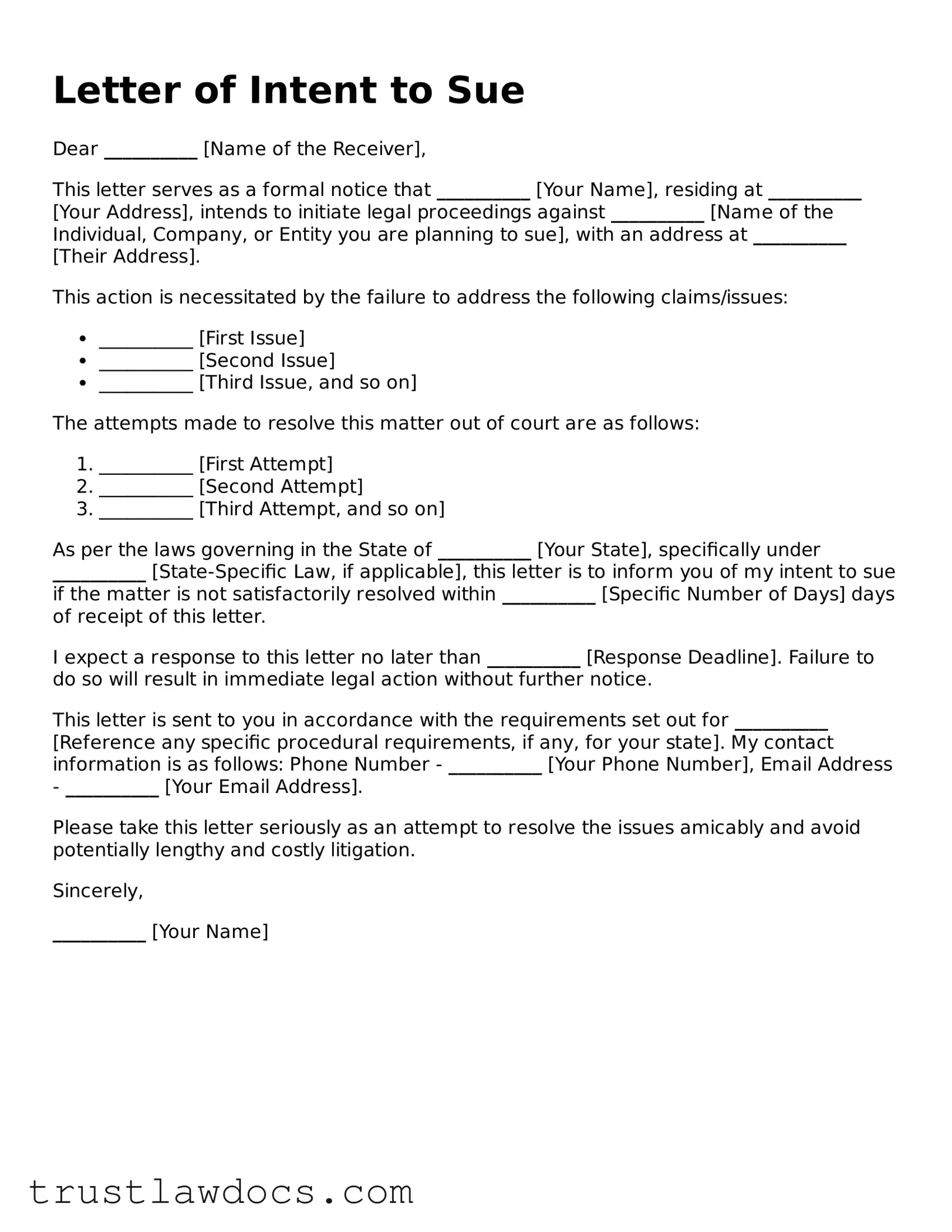What is a Letter of Intent to Sue?
A Letter of Intent to Sue is a formal document that notifies an individual or a business about your intention to initiate legal action against them due to unresolved disputes. It outlines the reasons for the potential lawsuit and offers a last chance to resolve the matter without going to court. This letter serves as a powerful tool for encouraging the other party to address the issue.
When should I send a Letter of Intent to Sue?
Before sending a Letter of Intent to Sue, it's important to attempt all other means of resolution. If those efforts have been unsuccessful and you believe your rights have been violated or you've suffered damages, this letter can be sent as a final step before officially filing a lawsuit. It's often used as a way to demonstrate to the court that you tried to settle the matter out of court.
What should be included in a Letter of Intent to Sue?
The letter should include a clear statement of your intent to file a lawsuit, a detailed description of the dispute, the legal basis for your claim, any demands for compensation or corrective action, and a deadline by which the matter must be resolved. It is also crucial to include any evidence supporting your claim to ensure the recipient understands the seriousness of the issue.
Do I need a lawyer to draft a Letter of Intent to Sue?
While it's possible to draft this letter on your own, consulting with a lawyer can greatly enhance its effectiveness. A lawyer can help frame your arguments more persuasively, ensure that all legal requirements are met, and anticipate possible defenses from the other party. A professionally drafted letter might also increase the likelihood of settling the dispute before going to court.
How is a Letter of Intent to Sue delivered?
For the letter to have legal standing, it must be delivered in a manner that can be verified. This usually means sending it via certified mail with a return receipt requested, which provides proof that the recipient received it. In some cases, the letter may also be delivered by a process server to guarantee delivery.
What happens after sending a Letter of Intent to Sue?
After sending, there are a few potential outcomes. The recipient may choose to ignore the letter, respond by agreeing to negotiate, or even start their legal defense preparation. If there's no satisfactory response by the deadline outlined in the letter, you may then proceed to file a lawsuit with the court.
Can sending a Letter of Intent to Sue negatively affect my case?
Sending this letter is a standard legal practice and generally does not negatively impact your case. In fact, it can show the court that you made a genuine effort to resolve the matter before resorting to litigation. However, it's crucial to ensure that the letter is factual and free from any language that could be construed as libelous or threatening.
Is a Letter of Intent to Sue legally binding?
This letter itself is not a legally binding document that obligates you to sue or the other party to settle. However, it is a formal declaration of your intent to initiate legal proceedings if the dispute is not resolved satisfactorily. It can be presented in court as part of the pre-litigation process.
What if I decide not to sue after sending the letter?
If you choose not to pursue legal action after sending the letter, it's a good idea to notify the recipient of your decision in writing. This can help avoid any potential confusion or unnecessary preparation for litigation on their part. Remember, sending this letter should not be done lightly, as it sets in motion a series of expectations and potential legal steps.
Can a Letter of Intent to Sue be used in all types of legal disputes?
While a Letter of Intent to Sue can be utilized in many types of disputes, its appropriateness and effectiveness vary depending on the case. It is commonly used in business disputes, contract issues, and personal injury claims. For some specialized legal areas, such as family law or bankruptcy, other pre-litigation steps may be more appropriate. Consulting with a lawyer about your specific situation can help determine if this is the right course of action.
